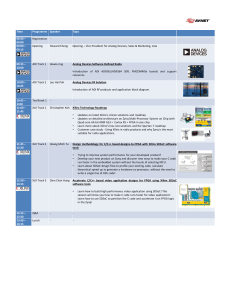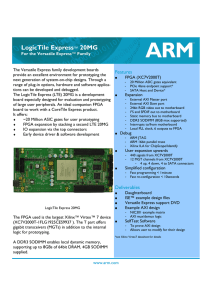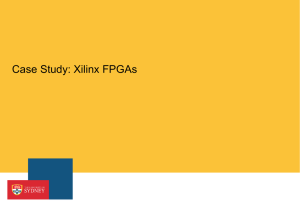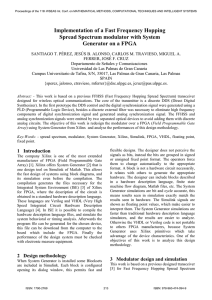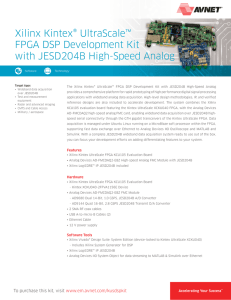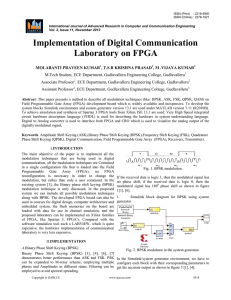Report II
advertisement
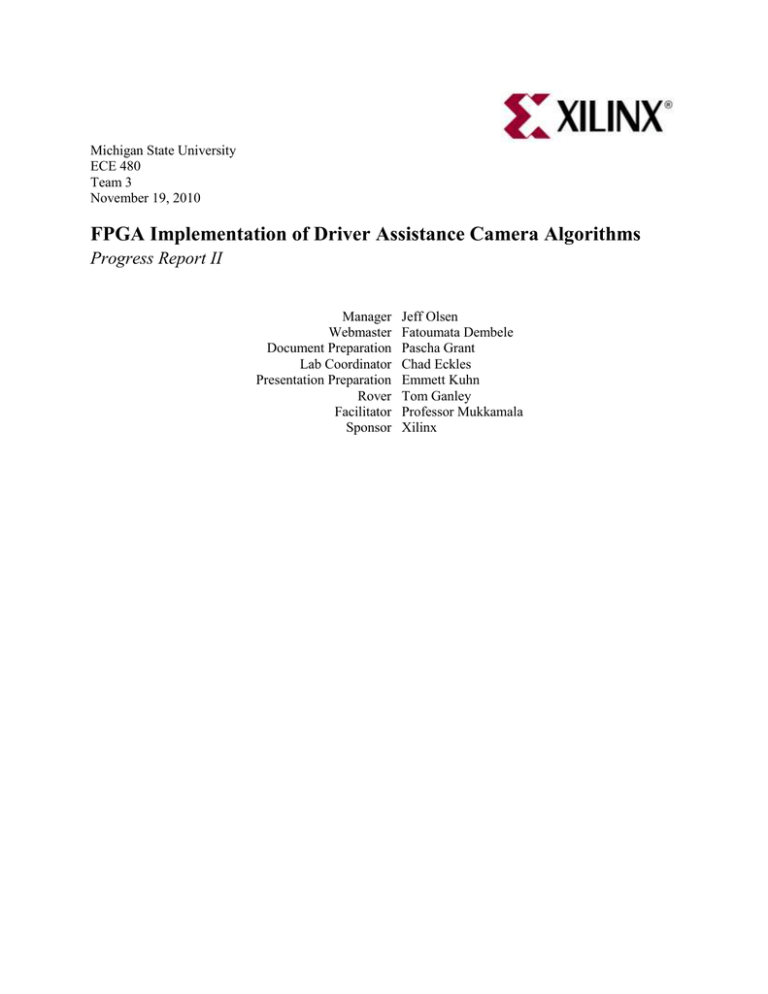
Michigan State University ECE 480 Team 3 November 19, 2010 FPGA Implementation of Driver Assistance Camera Algorithms Progress Report II Manager Webmaster Document Preparation Lab Coordinator Presentation Preparation Rover Facilitator Sponsor Jeff Olsen Fatoumata Dembele Pascha Grant Chad Eckles Emmett Kuhn Tom Ganley Professor Mukkamala Xilinx Progress Team 3’s progress can be divided into two categories: edge detection and object detection. The team is divided in half with each group working on these two main subjects. Edge detection has shown to have the greatest amount of success thus far with a significant breakthrough last week but object detection is expected to have a breakthrough soon and will then piggy-back off of edge detection’s success. A fair amount of progress has been made thus far with regards to edge detection; though the team is not completely finished with this portion of the project yet. Thus far, the edge detection algorithm that will be used in the final design has been finished using the lowest-level blocks known to the team, and the algorithm behaves properly on a still image in simulation. However, when the algorithm is attempted to be implemented on the FPGA development board, there are issues with the output video stream. The algorithm is implemented on the FPGA using the Camera Frame Buffer Demo that was provided to us by Xilinx. In the demo model are several blocks that achieve different functions such as filters, etc. We simply attached an additional subsystem to the original system, and named it “Edge Detection”. This block takes in the red, green and blue signals from the previous subsystem and sends the signals into our edge detection algorithm. It also receives the other signal necessary for functionality and simply by-passes them through the system. These were the only changes made to the system and we have located the problematic region in the system that is causing our incorrect video output. There are several factors in the frame buffer demo that must be set correctly in order for correct functionality. The largest factor in our current failures is the fact that our edge detection algorithm uses either a 3-line buffer or a 5-line buffer to take in either 3 or 5 lines, respectively, at a time before processing any of those lines. This is causing timing errors in our system, and we have yet to locate the solution to the problem. For example, there are multiple ways the sample periods can be set in the system, and coordinating these sample times has proven to be difficult, though we are nearly certain this has been resolved. There are also issues aligning the horizontal and vertical sync parameters with the video output signals. The edge detection algorithm introduces a very large delay to the video signals that was not present before its addition. This is an area we are attempting to expand our knowledge in, in order to gain confidence of our design. From what we have come to understand, correct synchronization of the signals is an issue. The lack of helpful documentation on the subject has led us to use our simulations in Simulink in order to force these signals to be synchronized correctly. We feel that we are currently very close to obtaining fully functional edge detection on the FPGA board using the camera, and that we should reach this goal very shortly. We are disappointed that we have been unable to correctly implement the edge detection design as of yet, though we are optimistic that the time spent on troubleshooting this system will save us a Page | 2 great amount of time when implementing our form of object detection. We have learned many minor details about the System Generator design environment, and are confident that our knowledge of the system from the errors we have seen in edge detection implementation will make for a much smoother transition to object detection. Object detection has been a much slower process but we are still hopeful. Object detection can be categorized by two methods: bottom-up detection or top-down detection. Top-down detection is a method of object detection in which the system knows what edge-shapes to look for (such as a circle) and then finds them within the image. The problem with this method is that object detection would be limited to specific objects; therefore the team would have to choose which objects were of greatest significance. The other method, known as bottom-up object detection, examines all pixels that have been deemed an edge and then groups the non-edges that are surrounded by the edge pixels and considers this space an object. The problem with this method is that there would be countless objects within the image; therefore the next step of this method is to look at the probability of one object being part of another object and then merging these two objects together. The team members who are working on object detection have examined both methods of object detection and agreed that the top-down method would be most appropriate for our project and for the limited remaining time we have. The group has located Matlab code which utilizes the Hough Transform to locate circles within an image and was demonstrated specifically for coin detection. Currently, those team members are attempting to convert the Matlab code into a form that can be used with Xilinx’s System Generator blocks. The current issue with this conversion is the team’s unfamiliarity with using loops (such as For Loops) within System Generator. There are also additional features of the code that will pose a challenge to the team as we translate it into System Generator’s basic blocks. The team is very hopeful that we will make a breakthrough with object detection soon. Overall, the team is very excited and enthusiastic about the project. Each member is working diligently to push the project towards completion for design day. Our expectation for the outcome of the project is to have fully functional edge detection for live video and to have object detection locate a simple figure (such as a circle) from a still/fixed image. If the team is able to resolve object detection with a still/fixed image with enough remaining time, then our hope is to implement the detection into live video for design day. It is unfortunate that our team did not have the necessary tools and information to be at this point earlier in the semester; nonetheless we are all optimistic about our final design. Page | 3 Gantt Chart Page | 4 Page | 5




